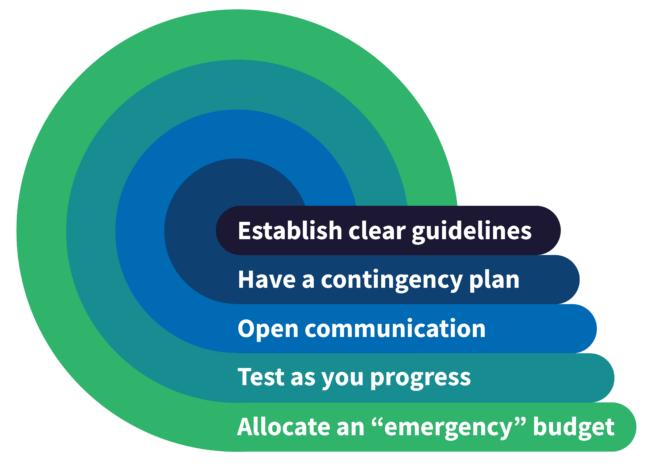Table of Contents
Setting project goals and expectations is equally important to the success of any custom web development or custom software development project.
Generally, this process involves collaboration between the customer, developers, and any additional stakeholders—such as project managers or investors. The process begins by outlining the desired outcomes for the project and then working with the development team to put together a detailed plan for achieving those goals.
The best way to manage this process is by instituting a timeline of deliverables—such as design mock-ups, testing periods, delivery schedules, and more—that need to be completed to reach the intended outcomes and to move on to the subsequent stage.
Once the timeline is established, you should have frequent communication with the development team to monitor their progress. The development team should provide regular progress reports as they work towards completing each goal in the timeline. Expecting a weekly or bi-weekly meeting is reasonable and often standard practice.
The length of the planning process typically depends on the complexity of the specific project and the resources available for its completion. It is also important to consider that more experienced custom development teams are more likely to have a time-tested process for creating project goals, reducing the time you need to commit at this stage.
On average, it can take anywhere from one week to several months for a custom development project to work through to completion. This is why it’s important to set realistic goals and expectations right from the start.
Proper feedback loops should be established early on in order to improve communication between all stakeholders. When it comes to communication during a custom development project, consider variables such as what tools to use, the number of total stakeholders involved, and how involved you want to remain.
Choosing the right tools for effective collaboration is the best way to communicate with developers throughout your custom development project. Some popular workflow management and communications tools include:
To reiterate, it’s important to consider how many people (and who) will be involved when choosing these tools. Tools like Slack limit how many workspaces each account owner can add.
Clients typically invite developers to collaborate within their set of workflow tools so there may be additional costs to consider if you have reached the threshold of that tool.
By using these tools, you help ensure everyone is on the same page throughout the development process and that your project is staying on track.
[Related: Digital Marketing Tools & Resources To Grow Your Business]
The typical process for tracking progress and addressing issues begins with establishing timelines and milestones, as well as creating a system for reporting progress at regular intervals through predefined communication channels.
This process can be as involved or hands-off as you want. It can involve weekly status updates or calls with the development team to ensure that any problems are identified early on and addressed quickly—or a monthly check-in for a top-level rundown.
However, you or a dedicated team member should be available to the development company throughout the process. That way you can provide feedback and guidance on the timeline, aesthetics, user experience, functionality, and other elements of the project. This also allows them to discuss any changes or add-ons to the project.
It’s also important for developers to troubleshoot possible issues throughout the development process and include you in the decision-making process. As one example, the debugging tools listed above help identify common bugs or performance issues quickly so they don’t delay the project timeline. If this tool was not included in the proposal and is only required for your project, there may be additional costs involved.
For aesthetic changes, both sides need to have a clear plan in place outlining what those changes entail to avoid any confusion or misunderstandings down the line. Any aesthetic discussion should be included in the initial planning and design stages.
Custom development teams manage the evolution of your product through the version control tools listed above. With each new iteration, a new version is created and stored within that respective tool. However, the data is stored as code so you will also need to establish how changes and revisions to the project are managed on your end.

To facilitate the effective feedback loop and management of changes and revisions, here are some tips that you should consider:
Throughout the custom development project, you can and should expect total transparency. The easiest way to ensure you and the developers are always on the same page is to establish the deliverables that help you manage the project.
As mentioned above, deliverables should include a number of documents such as a final timeline, project budget breakdown, user manuals, design assets, source code files, and more. All should be discussed when identifying project requirements.
Deliverables are especially important if you do not continue working with the development team after the initial project is completed. In any case, you can never account for unforeseen changes to the development team, their cost structure, and other variables that might delay your project or force you to switch teams. Having the deliverables ensure the project can proceed with the fewest interruptions possible.
Oops! We could not locate your form.
This page last updated on March 15, 2023 by Credo Team
Drive results for your marketing needs with the Credo network. Get started today (it's free and there is no obligation)!